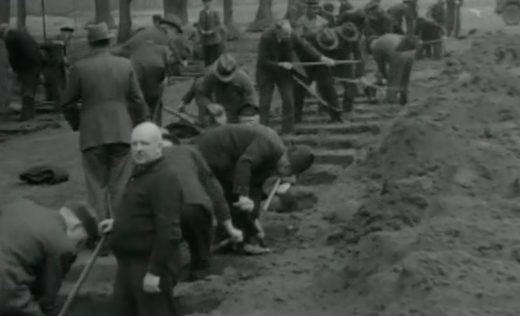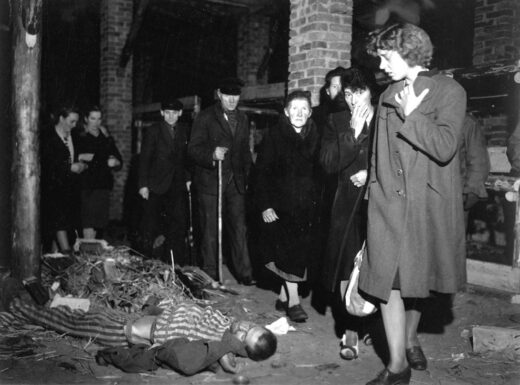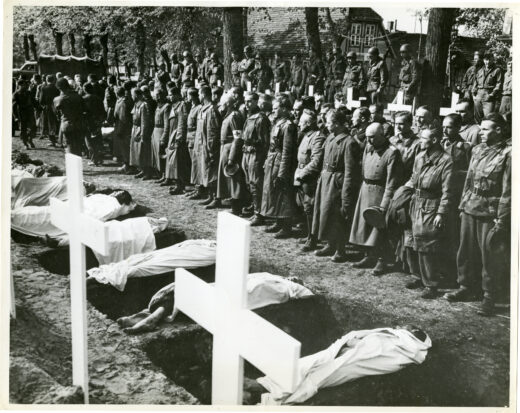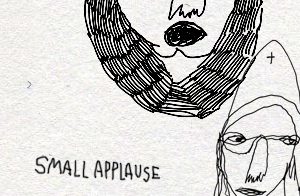With everyone talking about the 75th anniversary of the liberation of Auschwitz, my mind went, as it often does when thinking about the Nazi extermination camps, to my friend, the Atlanta folk artist Ned Cartledge. Cartledge, as I may have mentioned here before, saw the horrors of the Nazis firsthand toward the end of the World War II, when, as a 30 year old First Lieutenant with the 89th Chemical Mortar Battalion, he not only happened across the site of the Gardelegen massacre, where, just the day before, the Germans had set fire to some 500 political prisoners, burning them alive rather than allowing them to be freed by the advancing American troops, but also participated in the liberation of the Wöbbelin concentration camp. [Some 5,000 sick and starving people had been moved to Wöbbelin, which was a subcamp of the Neuengamme concentration camp, on the outskirts of Ludwigslust, by the SS, toward the end of the war, in order to prevent their liberation by the Allies. The camp was discovered, and the survivors freed, on May 2, 1945.]
I loved Ned “I say what I want to say—not cutesy things for folk art collectors” Cartledge. He was one of my very favorite people in the world. And one of my greatest regrets in life is that I did not spend more time with him when I had the opportunity. He was a truly incredible man, and, I suspect, to a great degree, I’m the progressive that I am today because of his influence. He was kind, thoughtful, and never shied away from addressing issues in his work like racism, sexism, religious hypocrisy and those instances where, in his eyes, this great nation of ours didn’t live up to its democratic ideals. [Having never met Kurt Vonnegut, I can’t say for certain, but I’ve always thought that Ned was to the folk art world what Vonnegut was to the literary world, and I think they would have loved one another, as they shared not only a history in battle, having served in World War II, but also a fondness for telling the truth through their work, and doing so with both biting wit, and a deep regard for their fellow human beings, informed by their Unitarian beliefs.] And our time together, talking about art and politics in his backyard, next to his enormous rosemary bush, is something that I’ll always cherish.
So, as I was thinking about the liberation of Auschwitz, it got me thinking back to these stories that Ned would tell me about the burned bodies he saw at Gardelegen, and the lifeless eyes of those he encountered at Wöbbelin, too weak and starving to do anything but stare blankly at their liberators. And it made me think about how these generations coming up after mine will likely never have an opportunity to hear a firsthand account of the holocaust from someone that they actually know and trust. And that, in turn, led me to start thinking about how this fact will likely play into the hands of the racists and holocaust deniers among us. So, I started looking around online, in hopes that maybe Ned had told his story to someone else, and that they might have had the foresight to write something down, so that, one day, I can say to my children, “I had a friend who helped liberate a concentration camp, and here’s his story.” And, as luck would have it, I hit pay dirt. It would seem as though, having heard a local social worker by the name of Lorrie Mell on television one night while at his Atlanta home, talking about the need to preserve stories of the holocaust, Ned reached out and offered to share his memories of the war. And, now, thanks to the Emory University digital archives, we can all read Ned’s interview about Gardelegen and Wöbbelin. Here’s an excerpt in recognition of the 75th anniversary of Auschwitz’s liberation.
MELL: Now you are going to tell me which camps you went into.
CARTLEDGE: The first time I witnessed anything of this nature was at a place called Gardelegen, an incident which was reported, I believe, in Life Magazine. After I came home from overseas, I did see some of the pictures of the Gardelegen incident, but these photographs that I have here are the ones that some of the fellows in my outfit took. Not me personally, but we developed them ourselves since they weren’t what you would call top notch photographs, but they do record some of the horrors of these things. And the Gardelegen incident was a case where the Germans had about 500 political prisoners, and, as the Allies moved in, they were moving these prisoners back so they wouldn’t be liberated by the Allies. I don’t know why this particular group was so important to them, but anyway they got to the point where they couldn’t continue to carry these political prisoners so they just decided to exterminate them. I don’t know exactly who they were, but we were told at the time that they were political prisoners. So they put them in this airplane hangar in the small airstrip in which there was straw on the floor, covered with oil, and they put them in there and set the straw on fire, and as the people tried to break out of the building, they were machine-gunned down. At the time we got there, the bodies were stacked up six or seven deep, mostly concentrated at the doors. Most of their clothing was burned from their bodies there and they were laying there. The Army came in and made the local German citizens in that area bury the bodies.
MELL: What kind of reaction did the German local citizens have to what they were seeing at this incident?
CARTLEDGE: It seemed to be a very matter of fact type of thing. I was told that one German refused to bury these people and he ran and he was shot by one of the American soldiers. I didn’t actually see the incident, but that was told to me when we went down to visit this particular spot.
MELL: How many people were burned in this hangar?
CARTLEDGE: About 500.
MELL: And how long after the incident did you arrive?
CARTLEDGE: We arrived probably the next day after it had occurred, but we came back on the second day to take the pictures. Some of the bodies had already been removed when we took the pictures themselves, but there were still quite a few bodies there.
MELL: Is there any other information around this particular incident that you want to be sure and include?
CARTLEDGE: No. We just happened on it by accident. We weren’t sent. With Ludwigslust, which was an actual concentration camp with buildings and barracks provided for prisoners, it was different. They asked if any of us wanted to go there to witness this…
MELL: The Americans had moved in prior to your arriving (at Wöbbelin)?
CARTLEDGE: I was not one of the first soldiers (at Wöbbelin), but there were still a number of prisoners there. I was appalled at the appearance of these people, who seemed oblivious to everything. They just sat around, up against the walls, with big, glassy eyes staring at us, and there were ambulances coming to take them away. In talking with some of the medical personnel, this one doctor told me that probably not many of them would survive, that their condition was so bad. They had been in starvation so long that probably not many of them would survive, even though they were living at the time.
MELL: What did they look like to you?
CARTLEDGE: They were just almost like skin and bones. They had on their traditional striped uniform, even though some of the uniforms were torn and worn, and you could see the bones, like at the knees, which were just like a big knot in the bones. Skin and bones so to speak. And the faces just real thin and emaciated looking and cheeks hollow, and the thing that impressed me most was the large eyes. They just almost looked through you. They didn’t look at you, they didn’t seem to be aware of us walking around, looking at this place. Inside some of these buildings was a type of latrine which was very primitive. It was just like a big concrete pit, even though it was built up from the floor, and it only had like two logs, or two rails, across the top for seating. One of the soldiers there told us that they had talked with one of the prisoners, and he said that the prisoners were quite ill and frequently they would be up on these poles, and the Germans would come through and push them off into this cesspool.
MELL: What else did you see at that camp? What did you learn?
CARTLEDGE: It was almost incomprehensible that one human would do another one that way. It was hard to comprehend and hard part to sink in and to understand why people would do things like that, but there it was. There was no contradiction as to what happened there. I mean it was evident to those of us who saw it, and I saw enough that I didn’t want to see much more of it. But near there supposedly was another camp. I didn’t see it but some of the other fellows in my outfit saw and reported it. They said it was for Jewish women only, and apparently they were still inside this enclosure, even though the Americans had just arrived there. Nobody had let them out or anything. They were starving practically, and the soldiers said they had some K rations and things, and they threw them over the fence. There was a mad dash for these things. Candies and anything that they had they threw into the fence to these people. They apparently had been without food for quite a number of days, but had not been released from the camps. The Germans had a lot of prisoners from other countries who worked on the farms, who were not imprisoned, and who seemed to be quite content with their role. Maybe they knew there would not be much chance of their escaping from Germany, but these people in this general area didn’t seem to be disturbed by these incidents. What few we came in contact with didn’t seem to know much about it…
MELL: Let’s go back a little bit. We talked about your being at the camp. When was the first time you recall hearing about these?
CARTLEDGE: I think pretty much having read in the paper prior to going overseas. I remember hearing about concentration camps probably well long before I was ever in the Army, but it didn’t really make a lot of impression on me at the time because there was not any vivid details given of these camps. I didn’t hear anything about the quantities of the numbers of people that were involved. I didn’t imagine that it was in the millions. I thought maybe a few thousand something. I don’t think many people in this country knew, but I realized that it was going on and to some extent the nature of Hitler’s German government. I, frankly, am not one of the ones who say well, this was only the Nazis and maybe a lot of good Germans had to do this and had to do that, because they were ordered to. I have not quite excused the German people as a whole for these atrocities myself. That may be a prejudiced or unfair view, but that’s still my point of view.
MELL: You condemn the whole German people for this kind of thing?
CARTLEDGE: Yes.
MELL: From what you saw?
CARTLEDGE: Yes, I am sure there were some people who couldn’t help it, but I am sure there were a lot of people who could have had some influence that didn’t make any attempt to do anything about it.
MELL: You think more, perhaps, could have been done than actually was?
CARTLEDGE: Yes.
MELL: It’s unforgettable for you. What is the message for other people?
CARTLEDGE: The message for other people is we don’t want to ever suppose that people are not capable of very inhumane treatment of other people, that you can’t assume that everybody is going to treat every one else like they’d like to be treated, and that as a result of political propaganda and other types of propaganda, an entire people can be persuaded to commit quite terrible things. Maybe a social atrocity so to speak.
MELL: Are you aware that there are some people that don’t believe this really
happened? They think it’s propaganda.CARTLEDGE: I suppose there could be some people, but it would have to be a very ignorant person, a very prejudiced type of person.
MELL: Prejudiced meaning they just don’t want to know?
CARTLEDGE: No, they don’t want to believe that. They think, as you say, it’s a lot of propaganda… I am no prophet, but I think if we were to have a severe depression, in which a lot of people were out of jobs, you’d see the Klan increase considerably, and would see a lot more of the type of activity that the Klan participates in.
MELL: Are you saying that in bad times a scapegoat is needed.
CARTLEDGE: Yes, that’s what I’m saying.
MELL: Is this what happened in Germany?
CARTLEDGE: Yes, I think that was true, I really do. In other words, it’s easier to get crowds to hate somebody than it is to love them. You can get up a crowd to go hate somebody or participate in some kind of violent group, but it is sometimes pretty hard to get a crowd to go out and do some good somewhere…
MELL: Did what you saw in the camp leave you with the need to insure to do something today to make sure something like this doesn’t happen again?
CARTLEDGE: Yes. This is what I do in my art work. This is one of the voices I have… I am not an articulate person, not a great speaker. I can’t get up before a group and expound my ideas about things, but through my art work I can. I do social commentary type things though and this was one
small voice that I had…
And, here, for context, is an excerpt from the United State Holocaust Memorial Museum entry on the liberation of the camp at Wöbbelin.
On May 2, 1945, the 8th Infantry Division and the 82nd Airborne Division encountered Wöbbelin. Living conditions in the camp when the U.S. 8th Infantry and the 82nd Airborne arrived were deplorable. There was little food or water and some prisoners had resorted to cannibalism. When the units arrived, they found about 1,000 inmates dead in the camp. In the aftermath, the U.S. Army ordered the townspeople in Ludwigslust to visit the camp and bury the dead. On May 7, 1945, the 82nd Airborne Division conducted funeral services for 200 inmates in the town of Ludwigslust. Attending the ceremony were citizens of Ludwigslust, captured German officers, and several hundred members of the airborne division.
On May 7, 1945, at the burial of these 200 deceased prisoners, here’s what the U.S. Army chaplain said to the people of Ludwigslust, who had been forced not only to visit the site of the Nazi atrocity, but also to dig the graves for the dead on the palace grounds of the Archduke of Mecklenburg.
“The crimes here committed in the name of the German people and by their acquiescence were minor compared to those to be found in concentration camps elsewhere in Germany. Here there were no gas chambers, no crematoria; these men of Holland, Russia, Poland, Czechoslovakia, and France were simply allowed to starve to death. Within four miles of your comfortable homes, 4,000 men were forced to live like animals, deprived even of the food you would give to your dogs. In three weeks, 1,000 of these men were starved to death; 800 of them were buried in pits in the nearby woods. These 200 who lie before us in these graves were found piled four and five feet high in one building, and lying with the sick and dying in other buildings…”
Under order of General Dwight D. Eisenhower, the Supreme Commander of the Allied Forces, the U.S. Army in Ludwigslust ordered “all atrocity victims to be buried in a public place” with crosses placed at the graves of Christians, and Stars of David on the Jewish graves, along with a stone monument to commemorate the dead. Here are photos of the citizens of Ludwigslust being forced to dig the graves, visit the site of the Wöbbelin camp, and attend the services for the dead.



The first image you see above was taken from a film shot by the U.S. military to record the conditions of the camp, and the reactions of the Germans who were made to confront the crimes against humanity that had been committed in their names. One hopes that future generations never forget.












7 Comments
Never again. Fucking thugs must be defeated by any means necessary.
Aloha, remember everything the Nazi did was legal and the “good Germans” were simply following the law.
Did I hear the titular head of the resistance / Democratic Party calling on popular mobilization to pressure the Senate?
I don’t know that saying the Republicans will be haunted is really going to cut it.
#neverforget
Follow the Auschwitz museum.
https://twitter.com/auschwitzmuseum/status/1221098891900334082?s=21
This is sobering, great piece, Mark. You did your friend proud
I’m struck by how well fed that one German gravedigger looks. Apparently the people of Ludwigslust were not going hungry.
I agree with Janette.
And yet we have Henry Herskovitz, a known Holocaust denier, and his followers, picketing an Ann Arbor synagogue every week. Thanks to Henry we have our very own hate group in our backyard… https://www.michiganradio.org/post/ann-arbor-organization-labeled-hate-group-splc